If you’ve noticed your plants wilting or showing signs of sunburn, you’re likely dealing with excessive sun exposure in your garden. While most plants need sunlight to thrive, too much can be just as damaging as too little. Your garden’s layout, plant selection, and protective structures all play vital roles in managing intense sunlight. Let’s explore the most effective methods to create balanced shade that’ll keep your garden flourishing through those scorching summer days.
Contents
Install Shade Cloth Structures

When your garden starts showing signs of sun damage, installing shade cloth structures provides an effective and flexible solution for protecting your plants. You’ll want to select a shade cloth that blocks 30-50% of sunlight for most vegetables, while delicate plants may need up to 70% coverage.
Start by installing sturdy support posts at each corner of your garden bed, spacing them no more than 8 feet apart. Connect the posts with strong wire or cables at the top, creating a framework that’s at least 3 feet above your tallest plants. Next, secure your shade cloth to the framework using UV-resistant zip ties or garden clips.
You can adjust or remove the shade cloth as seasons change, and it’s best to install it during morning hours when there’s less wind.
Plant Tall Shade Plants
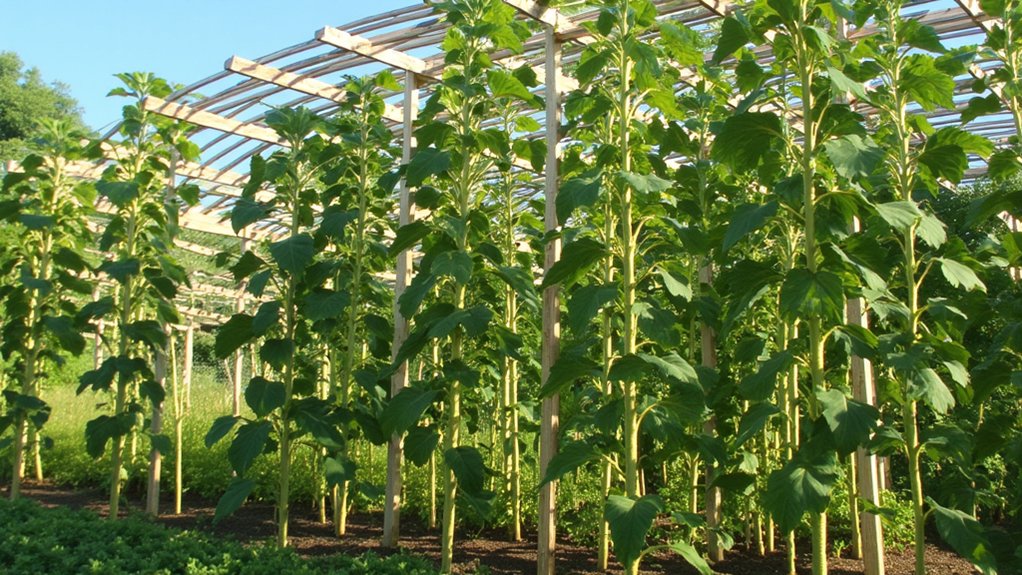
A natural alternative to artificial shade structures involves strategically planting tall, sun-loving plants to protect more delicate specimens. You’ll want to position these living screens along the western or southern edges of your garden, where they’ll cast afternoon shadows on heat-sensitive plants.
Consider fast-growing sunflowers, which can reach 8-12 feet in height within three months, or hardy Jerusalem artichokes that grow 6-8 feet tall. Corn stalks make excellent temporary shade providers during summer months, while climbing vines like pole beans can create vertical shade when trained up trellises.
For permanent solutions, plant deciduous trees like maples or locusts 15-20 feet from your garden beds. They’ll provide dappled shade during intense summer months while allowing full sun penetration during winter when their leaves drop.
Create Raised Garden Borders

Building raised borders around sun-exposed garden beds creates a natural barrier against intense heat and light reflection. You’ll want to construct these borders at least 12 inches high using materials like stone, brick, or cedar planks, which help deflect harsh sunlight and reduce soil temperature by up to 10 degrees.
Start by marking your border outline with string, then dig a 4-inch trench for your foundation. Layer your chosen materials, ensuring they’re level and secure. For stone or brick borders, use construction adhesive between layers; for wood, anchor with posts every 4 feet.
Add a layer of mulch along the inner edge of your raised border to enhance the cooling effect. You’ll notice the difference in soil moisture retention within two weeks, and your plants will show improved vigor during peak sun hours.
Add Mulch Layers Regularly
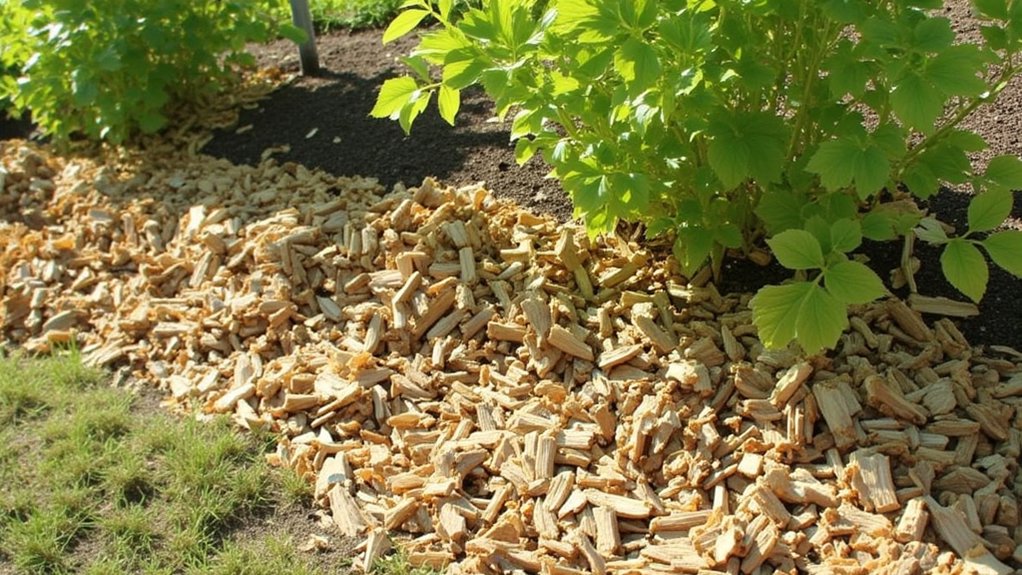
Since intense sunlight can quickly dry out garden soil, regular mulch application becomes your first line of defense against moisture loss and overheating. You’ll want to maintain a 2-3 inch layer of organic mulch, such as wood chips, straw, or shredded leaves, around your sun-exposed plants.
Apply fresh mulch every 3-4 months during the growing season, as the previous layer breaks down and thins out. Before adding new mulch, gently rake the old layer to prevent compaction, then spread the fresh material evenly around your plants, keeping it about an inch away from stems and trunks.
In areas receiving direct afternoon sun, consider using light-colored mulch materials like pine straw or bleached hardwood chips, as they’ll reflect more heat than darker options like cocoa hulls or bark nuggets.
Build Temporary Sunblock Walls
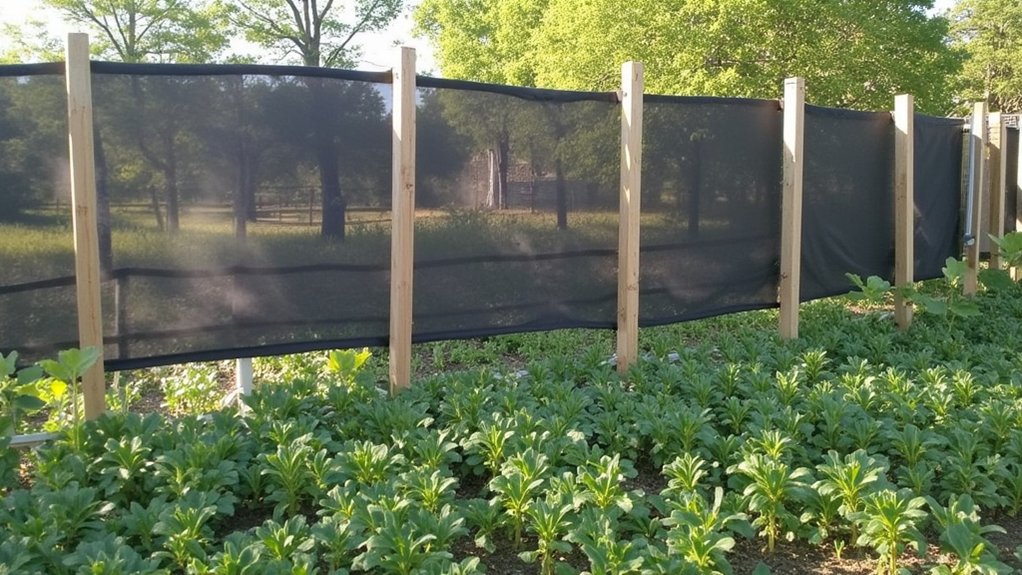
When intense afternoon sun threatens to scorch your garden, temporary sunblock walls provide targeted shade protection for vulnerable plants. You’ll need wood stakes, shade cloth, and zip ties to construct these simple barriers that can block 30-50% of harsh sunlight.
Install 4-foot stakes every 3 feet along the western or southern edge of your garden bed, pushing them 12 inches into the ground. Secure your shade cloth to the stakes using zip ties, making sure it’s pulled taut to prevent sagging or wind damage.
You can adjust these barriers seasonally, typically using them from late June through early September when sun exposure is most intense. For maximum effectiveness, position your walls at a 15-degree angle, allowing morning sun while blocking the harshest afternoon rays.
Install Garden Misters

Beyond physical shade barriers, garden misters offer a smart way to cool down sun-stressed plants through evaporative cooling. You’ll want to install misters about 4-5 feet above your plants, spacing them every 3 feet to guarantee even coverage. Connect them to your main water line using 1/4-inch tubing and pressure regulators set to 40-50 PSI.
Set your misters to run in 2-3 minute bursts during the hottest parts of the day, typically between 11 AM and 3 PM. You can install an automatic timer or manually activate them when temperatures climb above 85°F. Make certain the water droplets are fine enough to create a cooling mist rather than larger drops that’ll weigh down your plants.
Remember to clean your mister heads monthly with vinegar to prevent mineral buildup and maintain ideal spray patterns.
Place Potted Palm Trees
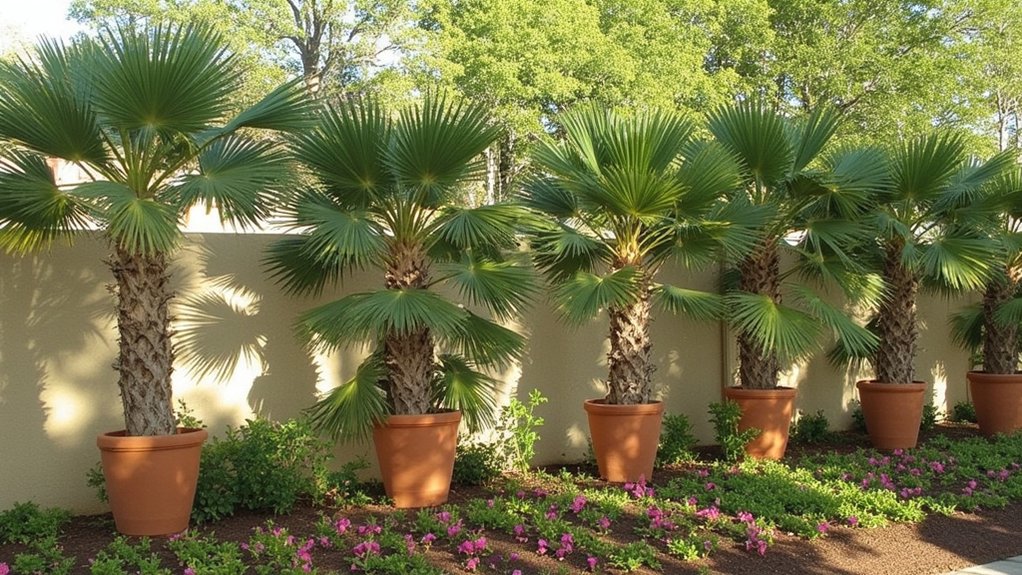
Although potted palm trees require significant maintenance, they’re one of the most effective natural shade solutions for sun-stressed gardens. You’ll want to select hardy varieties like Bamboo Palm or European Fan Palm, which can thrive in containers at least 24 inches deep.
Position your palms strategically, spacing them 4-6 feet apart to create overlapping shade patterns. For maximum protection, place them on the western side of your garden where afternoon sun is most intense. Remember to rotate the containers 45 degrees every month to guarantee even growth.
Keep the soil consistently moist but not waterlogged, and feed your palms with slow-release fertilizer every three months during growing season. When winter approaches, you’ll need to move containers indoors if temperatures drop below 45°F.
Set Up Shade Umbrellas
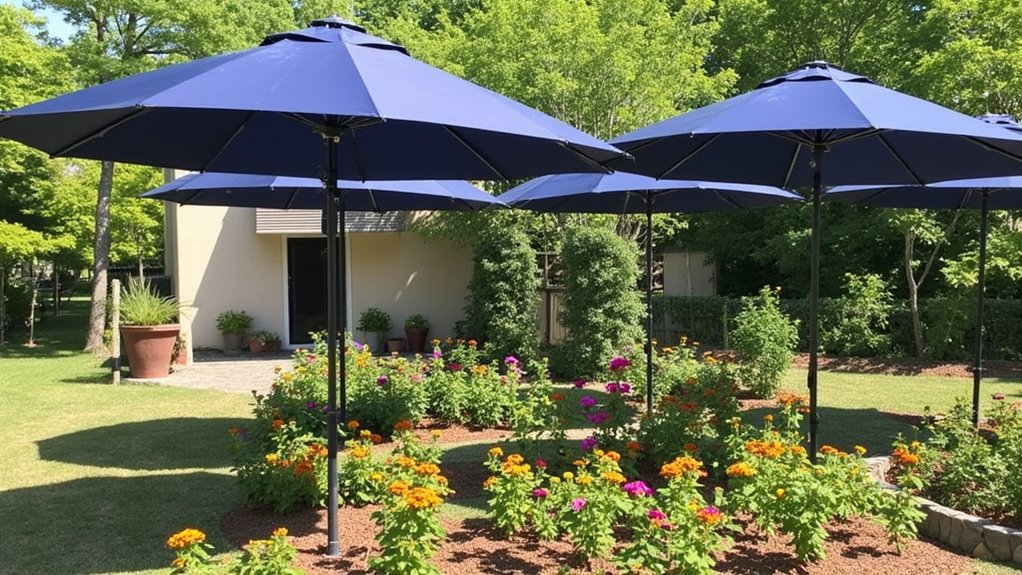
A well-positioned shade umbrella offers quick, flexible sun protection that’s more portable than container palms. When selecting your umbrella, opt for UV-resistant fabric and a sturdy base that weighs at least 50 pounds to prevent tipping in windy conditions.
Position your umbrella where it’ll cast shade during the hottest parts of the day, typically between 10 AM and 4 PM. You’ll want to choose a size that provides adequate coverage – a 9-foot diameter umbrella can shade approximately 60 square feet of garden space.
For maximum effectiveness, install multiple umbrellas in a staggered pattern, overlapping their coverage areas by about 2 feet. Don’t forget to close them during storms or high winds, and store them in a dry place during winter months to extend their lifespan.
Plant Climbing Vines

When your garden needs natural shade coverage, climbing vines offer an elegant solution that grows more effective over time. You’ll want to select varieties like wisteria, Virginia creeper, or morning glory that thrive in your climate zone and match your desired growth rate.
Start by installing sturdy support structures, such as trellises or pergolas, ensuring they’re at least 6 feet tall and securely anchored. Plant your vines 12 inches apart at the base, and train the young shoots to climb by gently weaving them through the support system.
Water deeply at the roots, and apply a balanced fertilizer every 6 weeks during the growing season. Most climbing vines will establish themselves within one growing season, creating a natural canopy that can reduce sunlight exposure by up to 75% in peak summer months.
Add Reflective Ground Cover

Ground-level protection can complement your overhead shade strategies in reducing sun exposure. You’ll want to start by laying down light-colored materials that reflect sunlight away from your plants, such as white pebbles, crushed shells, or marble chips.
Spread your chosen reflective material in a 2-3 inch layer around plants, leaving a 3-inch gap between the material and plant stems to prevent rot. If you’re working with larger areas, calculate roughly 1 cubic foot of material per 4 square feet of garden space.
For maximum effectiveness, combine light-colored ground cover with moisture-retaining mulch underneath. You’ll need a 1-inch layer of organic mulch beneath your reflective material, which helps maintain soil temperature while the top layer deflects harsh sunlight away from your garden beds.
